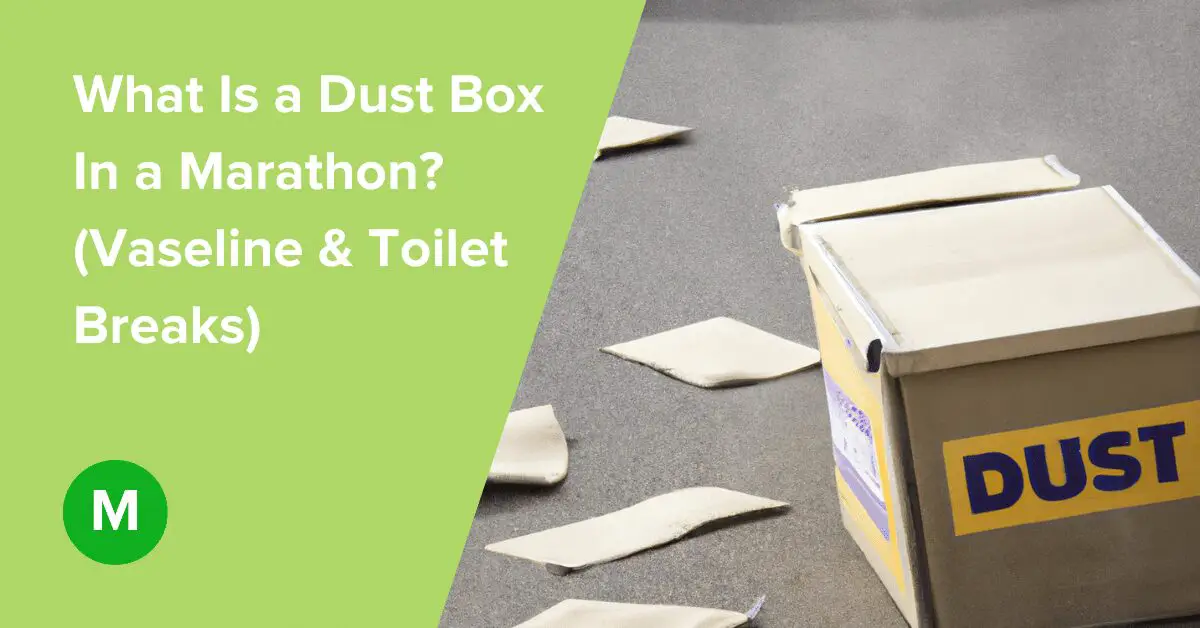What Is a Dust Box In a Marathon? (Vaseline & Toilet Breaks)
A dust box in a marathon is an integral part of the race.
It helps keep runners clean and free from debris. Without a dust box, the course would be covered in dirt and dust, making it difficult for runners to pass.
This blog post will discuss a dust box and how it affects the marathon race. We will also provide some tips on properly using a dust box.
What is a dust box in a marathon?
A dust box is a container used to collect dust and debris during a marathon.
The box is typically placed at the start of the race, and runners are encouraged to deposit any trash they accumulate during the race into the box. This helps to keep the race course clean and safe for all participants.
Dust boxes, such as aid stations or water stops, are often placed at other points along the course. This allows runners to dispose of garbage they may have accumulated before reaching the finish line.
Dust boxes are essential to keeping marathon courses clean and safe for all runners.
There are many types of dust boxes that are used in different marathons. Some of these include:
- Dust boxes for long-distance runners
- Dust boxes for marathoners
- Dust boxes for cross-country skiers
- Dust boxes for snowboarders
Dust boxes are an essential part of the marathon. They keep the course free of debris that would otherwise cause damage to the runners or vehicles on the route.
These boxes are usually located at critical locations along the course, such as intersections, bridges, and other areas where runners could become exposed to debris while passing through them.
Do you have to pee during a marathon?
The answer, of course, is that it depends on the situation. Some runners find that they need to stop and relieve themselves mid-race, while others can make it the entire 26.2 miles without a pit stop.
So what factors play into whether or not you’ll need to take a break to visit the bathroom during a marathon?
First, how much water are you drinking leading up to the race? If you’re well-hydrated, you’re more likely to be able to hold it in during the race.
Second, how much have you eaten? A full stomach can add extra pressure on your bladder. And finally, your anatomy plays a role – some people have smaller bladders than others.
If you’re worried about needing to stop for a bathroom break during the marathon, you can do a few things to prevent it.
First, cut back on your fluid intake in the hours leading up to the race. And second, use the porta-potties at the start line before the race begins. That way, you’ll hopefully be able to make it to the finish.
Can you go to the toilet during a marathon?
Going to the toilet during a marathon is a question every runner has asked at some point. The short answer is yes, you can—however, a few things to remember if you need to make a pit stop during your race.
First, remember that every time you stop, you lose time. If you can, try to find a portable toilet along the route. If there isn’t one available, you can always try to find a bush or tree to hide behind. Just be sure to be discreet.
Also, be prepared for your body to feel sluggish after going to the bathroom mid-run. It’s not uncommon for runners to experience an energy slump after using the restroom, so make sure you have enough fuel in your tank to power through it.
Finally, don’t forget to wash your hands afterward. Marathon running is challenging enough without having to worry about getting sick.
So there you have it: yes, you can go to the toilet during a marathon. Just be mindful of the time, and please wash your hands.
Why do they give out vaseline at marathons?
Marathon runners mainly use vaseline to prevent chafing. The oil forms a protective layer that locks in moisture.
Nipple chafing, in particular, can be a big problem if not treated. The American Academy of Dermatology recommends using vaseline to cover chaff points and blisters. It also can be applied to areas to prevent chafing in the first place.
The vaseline will help to protect and heal irritated areas faster.
It’s not just to prevent chafing (although that is one benefit).
Vaseline with SPF also helps to protect skin from the sun’s ultraviolet rays.
It forms a barrier on the skin’s surface, reflecting some of the UV radiation and helping to prevent sunburn. Marathon runners are especially susceptible to sunburn because they are often out in the sun for hours.
What is a dust box in Japan?
The dust box is a plastic trash container that may be used both inside and outside. It is designed to be placed on the ground and has a lid with a handle to lift it when you need to throw something away.
The dust box is also known as the “trash bin,” made of metal or plastic.
The dust box was first used in Japan in the late 1800s but had problems. For example, when people threw away their trash in the early 1900s, they often left it out for days or weeks without anyone cleaning it up. This led to many diseases from insects such as fleas and flies who lived on human corpses.
To help solve this problem, Japanese engineers came up with the idea of using plastic instead of metal. They thought that plastic could be cleaned more easily than metal and would not rust over time as metal did. The first version of this new invention was called “shimose” (meaning “clean”).
What is a dust box in Tokyo?
A dust box is a waste container placed along the route of the Tokyo marathon, specifically for disposing of runners’ tissues and other trash. Dust boxes are positioned at critical points along the course so runners can easily reach them during the race. They are typically placed near water stations and at the finish line.
The purpose of the dust box is to keep the course clean and tidy for future races. Tokyo’s marathon is one of the most popular races in the world, and it attracts runners from all over the globe.
When the dust boxes were first introduced, they were only placed along central sections of the course where there was a greater concentration of runners. They are now installed on all five courses (Central, Eastern, Western, Northern, and Southern). Still, they are not accessible to every runner.
This means some runners must carry their bags and dispose of them after finishing their events. The dust boxes also come with a warning sign which explains what materials cannot be disposed of in them and how to discard these items properly.
In recent years, the race has become increasingly competitive, with runners looking for any advantage. The dust box provides a simple but effective way to keep runners’ energy levels up and help them stay focused on the task.
Round up
When planning a marathon, the course must be kept clean. If a marathon doesn’t have a dust box, it will be difficult for the runners to pass. In addition, a dust box can keep the track free of dirt and smudges.
The dirt on the track could also cause problems for runners competing where it is hotter or colder than average.
Ultimately, being prepared by knowing what a dust box is and learning how to use one properly can make all the difference in keeping your race as safe and enjoyable as possible.








